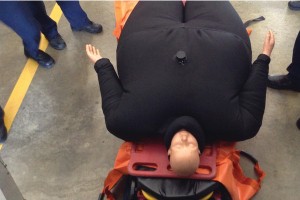The Summa Health System in Ohio is providing area agencies with both the medical knowledge and the physical practice needed to safely manage bariatric patients.

The Summa Center for EMS at Summa Akron City Hospital in Akron, OH has answered a call from responders in the region to address a perceived increase in the bariatric population and questions about their associated medical and transport needs.
The Summa Health System provides medical direction to 20 EMS agencies, ranging from rural to urban, says Associate EMS Director Bradley Clarke, DO, FACEP.
“We initially started the program in 2012,” Clarke says, “after receiving questions about the differences in treating and transporting bariatric patients and any special equipment needs. One of our challenges was that we don’t usually do centralized training and had to put together something somewhat mobile to take to each location.”
The four-hour program begins with a one-hour lecture and then moves into skills and scenarios that include both trauma and medical issues.

Training topics include differences in bariatric anatomy and physiology, responder safety, sensitivity and professionalism.
Coming up with simulation aids for the skills stations proved challenging, Clarke says. “There are not a lot of simulation aids for bariatric patients,” he says, that provide specialized training opportunities for venous access, airway management and CPR.
As a solution, they developed some of their own simulation aids using ballistics gel and “some trial and error,” Clarke says. One of their team members, Jonathan R. Zalewski, RN, NREMT-P, experimented with a recipe for Knox Gelatine and worked to develop his own methods for creating gel molds to place on a manikin’s arm or neck.
“It’s been interesting to try to perfect the technique,” Zalewski says. He adds that while the molds are somewhat reusable, the gel can simply be remolded so they make a fresh batch for each class.
One of the commercially available items they do utilize is a bariatric suit that gets placed on a regular manikin and then filled with water to a weight of 400 lbs. Clarke notes the suit can be filled once the manikin has already been placed in a difficult or confined space such as a stairwell or bathroom to simulate realistic extrication challenges.
As for any funding and purchasing for the program—it was “none,” Clarke says.
“We have a cache of training equipment and didn’t need anything additional for this. The idea was to take what we’ve got and what the departments have and put together a home-brewed program.”
Based on conference feedback, Clarke says it is apparently unusual to have crews go through a training exercise to physically treat and move a bariatric patient. While there was some concern about training safety and “some good-natured grumbling” about the effort, Clarke says those in fire/EMS are generally comfortable and familiar with the concept that it’s better to face a safety issue in training than for the first time in the field.
The EMS agencies in the region range in their access to specialized equipment; for example, some have power cots, while some have nothing, Clarke says. Discussions include body mechanics, lift techniques and utilizing tarps with handles. “You really don’t need a lot of specialized equipment if you have the manpower,” Clarke says. That in itself—calling for additional help for a bariatric response—is one of the points made in the class.
“The take-away would be that EMS agencies do need this training on the differences in medical and transport issues, and that the program can be put together easily and cheaply,” Clarke says.
This article originally appeared at EMSWorld.com on Feb. 13, 2014 and in EMS World magazine in March 2014.
